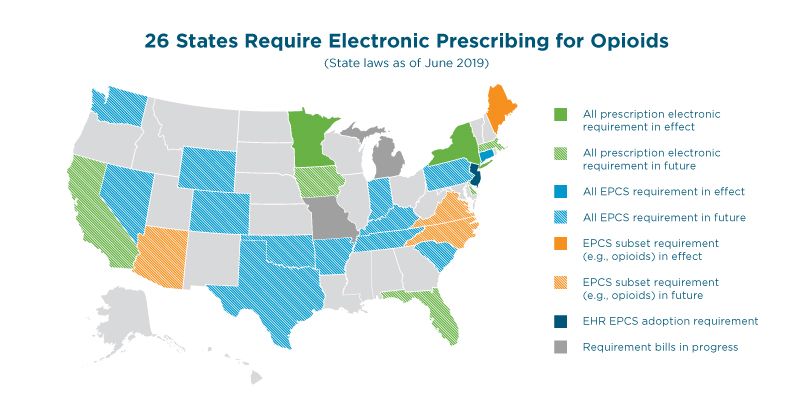State and Federal Laws Enacted to Drive Physician Use of Electronic Prescribing for Controlled Substances (EPCS)
ARLINGTON, Va. – July 1, 2019 – The nation has reached a major milestone in its fight against the opioid epidemic, with more than half of all states requiring the use of electronic prescribing for opioids, controlled substances or all prescriptions.
On June 14, Texas Governor Greg Abbott signed H.B. 2174, followed by Florida Governor Ron DeSantis signing H.B. 831 on June 18, and Delaware Governor John Carney, Jr. signing H.B. 115 on June 27.
This means that the U.S. has passed the halfway point in its effort to enact requirements meant to spur adoption of Electronic Prescribing for Controlled Substances (EPCS), and arm prescribers with the technology they need to safely, securely and efficiently prescribe controlled substances, including opioids for pain management.
“We’ve worked across the Surescripts Network Alliance® and with industry partners in states from coast to coast to ensure that this powerful technology realizes its full impact on patients and the people who care for them,” said Tom Skelton, Chief Executive Officer of Surescripts. “To combat the opioid crisis—one of the biggest issues in healthcare today—we must all work together to digitize prescriptions and arm care providers with the actionable intelligence they need to make optimal care decisions and deliver adequate pain management.”
State and federal legislators have increasingly recognized the value of EPCS because it replaces paper prescriptions and helps eliminate the risk of theft or forgery. When combined with electronic access to patient medication history data and other tools at the point of care, providers can identify potential misuse and enhance the accuracy, security, privacy and efficiency of the prescribing process.
As of 2018, 95% of pharmacies were enabled for EPCS, although prescriber enablement lagged behind at 32%. And while 85% of prescriptions for non-controlled substances were sent electronically last year, just 31% percent of controlled substance prescriptions were sent electronically (a 10% increase from 2017).
Prescribers in states where electronic prescribing is required by law have driven substantial growth in enablement and adoption of EPCS. In New York, the I-STOP law helped increase prescriber and pharmacy enablement of EPCS to 77% and 98% respectively. And in 2018, 85% of all controlled substances in the state were prescribed electronically, according to Surescripts 2018 National Progress Report.
At the federal level, the SUPPORT for Patients and Communities Act (H.R. 6), which Congress passed and President Trump signed into law in October 2018, requires the use of EPCS for all controlled substances under Medicare Part D by January 1, 2021.
Prescribers can visit www.GetEPCS.com to learn how to implement the technology.


 Dean Riggott Photography
Surescripts
Dean Riggott Photography
Surescripts

